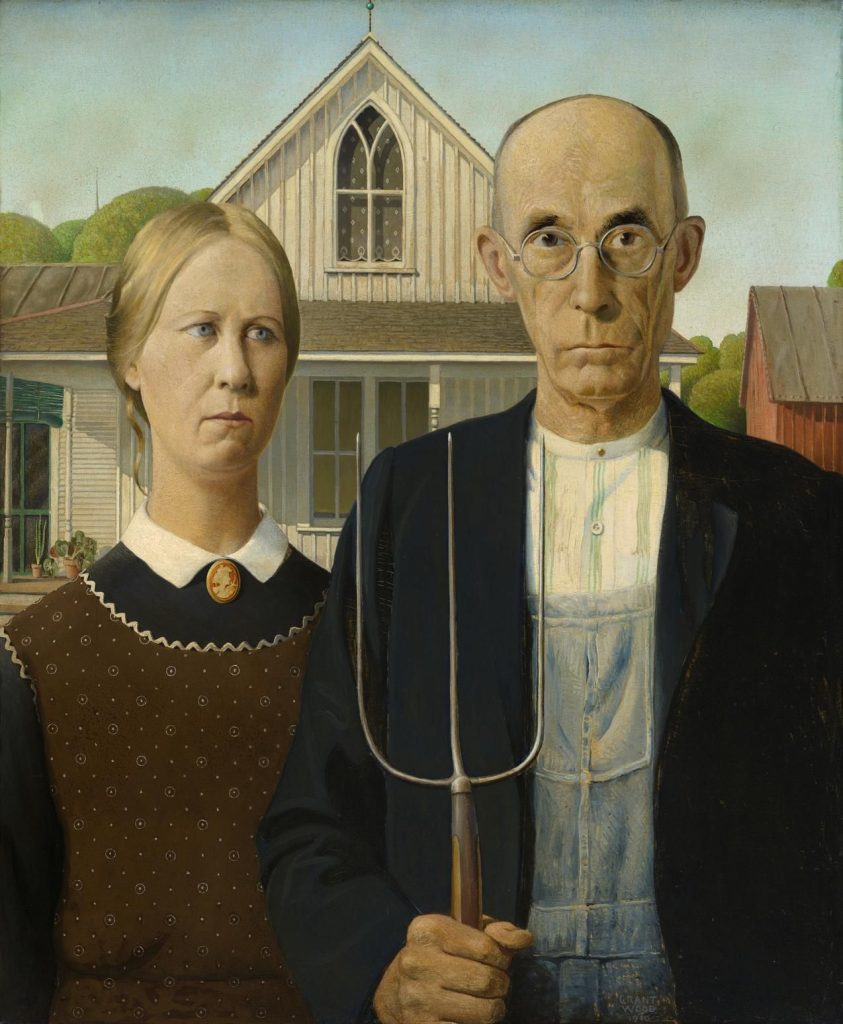
Grant Wood’s “American Gothic” now hangs at the Art Institute of Chicago. And on the museum’s website you’ll find a little background information introducing you to the iconic 1930 painting:
The impetus for the painting came while Wood was visiting the small town of Eldon in his native Iowa. There he spotted a little wood farmhouse, with a single oversized window, made in a style called Carpenter Gothic. [See it here.] “I imagined American Gothic people with their faces stretched out long to go with this American Gothic house,” he said. He used his sister and his dentist as models for a farmer and his daughter, dressing them as if they were “tintypes from my old family album.” The highly detailed, polished style and the rigid frontality of the two figures were inspired by Flemish Renaissance art, which Wood studied during his travels to Europe between 1920 and 1926. After returning to settle in Iowa, he became increasingly appreciative of midwestern traditions and culture, which he celebrated in works such as this. American Gothic, often understood as a satirical comment on the midwestern character, quickly became one of America’s most famous paintings and is now firmly entrenched in the nation’s popular culture. Yet Wood intended it to be a positive statement about rural American values, an image of reassurance at a time of great dislocation and disillusionment. The man and woman, in their solid and well-crafted world, with all their strengths and weaknesses, represent survivors.
Above, you can see Wood’s sister and dentist–otherwise known as Nan Wood Graham and Dr. B.H. McKeeby–posing in front of “American Gothic” in 1942. That’s when the painting first went on display in its hometown, Cedar Rapids, Iowa. It’s a fairly meta moment. Graham and McKeeby look downright dour in the picture, just as in the painting.
Grant Wood died of pancreatic cancer in ’42, and his sister eventually moved to Northern California, where she became the caretaker of his legacy. She did, after all, owe him a debt. “Grant made a personality out of me,” she said. “I would have had a very drab life without [American Gothic].”

If you would like to sign up for Open Culture’s free email newsletter, please find it here. It’s a great way to see our new posts, all bundled in one email, each day.
If you would like to support the mission of Open Culture, consider making a donation to our site. It’s hard to rely 100% on ads, and your contributions will help us continue providing the best free cultural and educational materials to learners everywhere. You can contribute through PayPal, Patreon, and Venmo (@openculture). Thanks!
Related Content:
Whitney Museum Puts Online 21,000 Works of American Art, By 3,000 Artists
Smithsonian Digitizes & Lets You Download 40,000 Works of Asian and American Art


Hello! Thanks for posting the newspaper photo. I’ve been reading about Wood recently in The New Yorker and have had the pleasure of viewing American Gothic at the Art Institute. However, I believe that American Gothic currently hangs in the Whitney Museum: https://whitney.org/Exhibitions/GrantWood